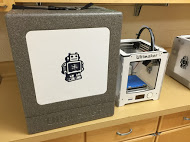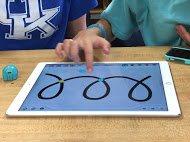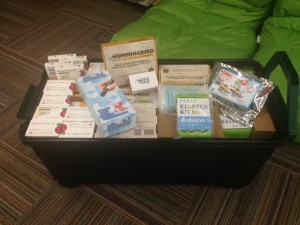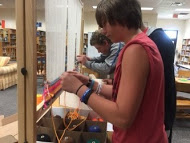Mobile Maker Spaces

The production cart includes a tripod with iPad Pro mount, a piano keyboard, professional lighting, mics, headphones, and various items to help students produce movies, videos, and podcasts.
The concept was pretty straightforward, but the logistics were a bit complicated. We wanted to create four mobile maker space carts that could rotate among four middle school libraries in the Knox County School district of Knoxville, TN. It all started when our director of instructional technology, Theresa Nixon, encouraged us to apply for a TeacherPreneur Grant to fund a traveling maker space program. Our funding goal was approximately $50,000. Requesting this much money meant that we needed a an idea that dazzled. As we prepared the grant application, the librarians representing the middle schools (Farragut, Vine, Carter, and Karns) discussed rotating maker space carts that would dock in each library for nine weeks. We hoped to optimize accessibility to high-ticket items such as 3-D printers and keep our libraries dynamic with new projects.
The Art Cart features duct tape and items for screen printing, letterpress, zine making, sewing, and more.
What we bought and why
As we discussed our vision for the individual carts, we saw thematic patterns emerge. We wanted an art cart and a STEM cart. Then we added a production cart, packed with tools to produce short films, podcasts, and stop-motion animation. An additional one was dedicated to 3-D printing. The majority of our proposed budget would go toward stocking these carts. However, we also purchased items that could be kept at stationary maker space areas in each library—the docking stations. Our decisions were collaborative, and over the course of a week we worked to outline our budget. As it developed, we continued to add to our wish list of items knowing that we could discuss, change, and customize it as needed. Creating the budget was both exciting and daunting as we determined what we wanted—and the necessary support tools and/or accessories.
The Ultimaker 2 Go 3-D printers come with an easy-to-carry case (left). Printing supplies, filament, tools, and other materials stay at the docking stations.
If we ordered a sewing machine, must we order needles and bobbins? Probably. What about a book on sewing? Definitely. We bought STEM cart items such as Arduinos and Raspberry Pis with the confidence that we were capable of learning to use them. No one on the team had used a 3-D printer, but we were excited to offer these opportunities to our students.Our group also referred to a variety of published maker space lists. These were helpful—and occasionally overwhelming. Without preconceived notions of what we wanted, we spent several late nights researching products and scouting the best prices, while calculating how many of each item we needed. (What does this do? And should we buy 48 of them?) Quickly, however, we became experts, knowing what type of wireless microphone works best with an iPad, for instance, and making sure we ordered instructional DVDs for screen-printing or robotics. In the process, we’ve become informed educators.
What's on the carts? Check it out!
Purchasing process; designing the docks

Student use iPad Pros to program the Ozobots.
We bought as many items as possible from single vendors such as Amazon, Blick, and Maker Shed, which helped get the orders moving and the products in hand. As far as the purchasing process, our IT director determined that the ordering and payments would run more smoothly if it was centralized in one school location, rather than at the district level.
The STEM cart features Arduinos, Raspberry Pis, BrushBots, and more circuitry and robotic items.
The biggest issues were identifying vendors who would work with purchase orders—and encountering vendors who didn’t have items in stock. Overall, most of the vendors have been great to work with, especially given billing and shipping didn't always match.up and running

Each school library has a loom that doesn't travel.
The carts are currently docked at the first stop in their rotations, and we're getting positive feedback from students and teachers. We’ve been surprised and inspired by what the students are creating: a movie by seventh graders welcoming rising fifth graders to the middle school; podcasts on the topics of teen driving, "If I had 24 hours to live," and other self-chosen themes. Students who formed a club had the goal of becoming Arduino experts and peer instructors. We’ve loved showing students how to make a gummi- worm piano keyboard with Makey Makey and watching their facial expressions transform from skepticism to wonder as they play the worms. Seeing students
A maker cart on the move.
expand their thinking while enjoying the maker space inspires us to figure out how to operate a Raspberry Pi—or collaborate with a math teacher to demonstrate the concept of cross sections using the 3-D printer. We’re fortunate to have support from our administrators, school, and community. Not all of them entirely understand the maker space movement yet, but they're curious. That’s all we need.
Mica Johnson, Brittany Witte, Jennie Randolph, Rachel Smith, and Karen Cragwall are librarians at Knox County Schools.
RELATED
The job outlook in 2030: Librarians will be in demand
The job outlook in 2030: Librarians will be in demand
ALREADY A SUBSCRIBER? LOG IN
We are currently offering this content for free. Sign up now to activate your personal profile, where you can save articles for future viewing






Add Comment :-
Comment Policy:
Comment should not be empty !!!
Elaine Deja
Great information! I'm curious as to wireless mics for the IPads you purchased? I need to get some but don't know which are the best. Thank you for the article. ElainePosted : May 09, 2016 08:42
Nathan DiClaudio
Excellent read, and very anxious to see what kind of things these young creatives can do with the resources!Posted : May 04, 2016 06:45
Heather Mitchell
What a great article! This entire idea looks so exciting! Im hoping there will be follow-up articles showing us how this all turns out! It is evident that a lot of work has gone into this!Posted : May 04, 2016 06:25
Brad Thibodeaux
this is an excellent article, very informative and inspiring! i can't wait to see what's nextPosted : May 03, 2016 11:50
Anna
This article highlights the importance of creativity in schools. I love it!Posted : May 03, 2016 11:27
Stephen Horrocks
Excellent information in this! I am excited to see what comes of the 3D printing and the podcast production from the kids. Very cool.Posted : May 03, 2016 07:32